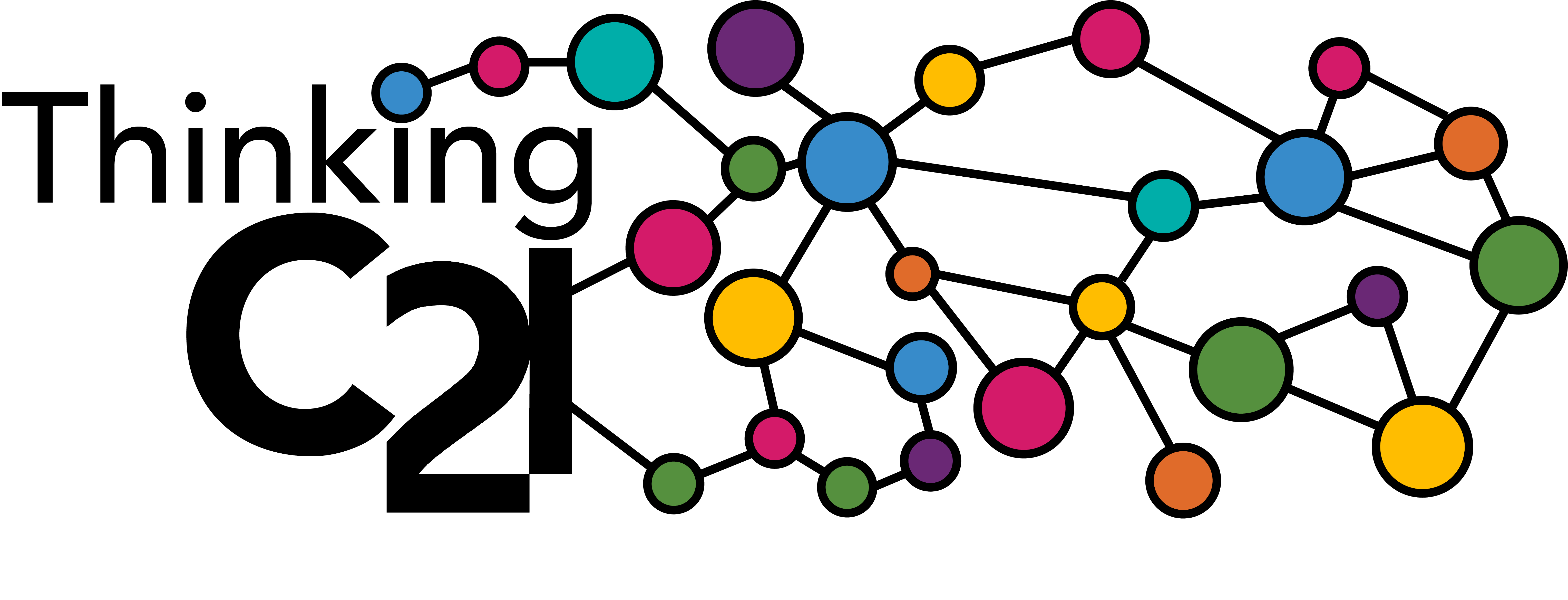by Maureen Ryan
In a well-timed bid for the attention of television audiences brimming with New Year’s resolve, Netflix released Tidying Up this January, a domestic advice program starring the Japanese organizational expert Marie Kondo, whose 2014 book The Life-Changing Magic of Tidying Up topped bestseller lists. On each episode of Tidying Up, Kondo visits a Californian family with her translator Marie Iida to help them implement the KonMari method (as Kondo calls it) of domestic organization, the key principle of which is to only keep belongings that “spark joy” in your life.
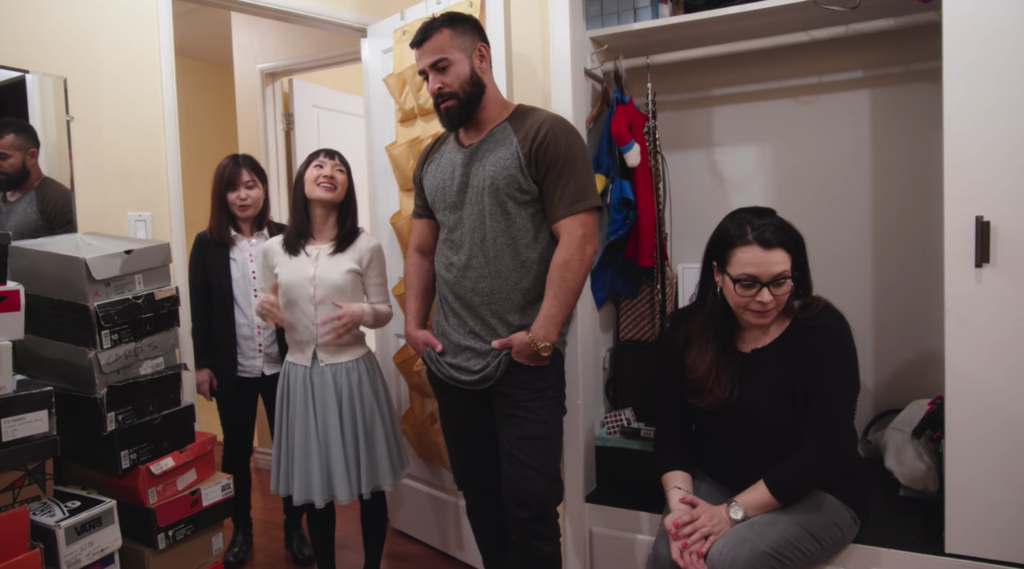
Like most makeover reality programs, Tidying Up is governed by a logic of transformation: the participants learn how to discern what sparks joy, and ends with a “reveal” that compares the unkempt “before” with the tidy, happy “after.”Unlike other makeover reality programs, though, the “after” lacks the dramatic punch that makeover audiences typically enjoy. Where before there was a linen closet with a loose jumble of towels, after Marie Kondo helps the participants transform their home, the closet has fewer, slightly neater towels….in rolls.
The low stakes are unusual for reality television, which typically relies on extremes of behavior or lifestyle for its dramatic fascination. The very ordinariness of people’s homes on Tidying Up is intentional, as is the fact that the transformations wrought in them are reasonably achievable. The show presents eight variously situated American households in each episode: there are couples of color, young people and retirees, gay and lesbian couples, couples with and without kids. Each of these recognizable “types” is intended to hail a wide variety of viewers at home. The staging of a transformation of an ordinary person is meant to implicate the viewer and make them feel accountable, in ways large and small, to Kondo’s domestic advice. The gentle call to action in the makeover is meant to elicit affects both positive and negative. It feels personal because something about it is.
And indeed, anecdotal evidence suggests that many people in this show’s audience have been inspired to “KonMari” their own homes. Others have also been repelled by the show’s attempts to hail them. Like the book before it, Tidying Up ‘s release elicited a barrage of heated responses, inspired testimonials, explainers and takedowns.
Around the same time, Buzzfeed published Anne Helen Peterson’s essay “How Millennials Became the Burnout Generation,” and like Tidying Up, it seemed to strike a nerve with audiences. In her essay, Peterson argues that burnout is not simply a discrete experience after a stressful period, but an essential, grinding condition of life for millennials (those born in and after the 1980s). Her investigation begins when she realizes that she, like others in her generation, had trouble accomplishing mundane tasks ranging from the moderately consequential, such as taking knives to get sharpened, to the crucial, like filling out insurance claims paperwork. From this, she extrapolates the relentless pressure on millennials from a very early age to “optimize” their lives and future prospects with resume-building extracurriculars and career-focused education. Children of this generation had very little unstructured time: she argues that “unchanneled energy (diagnosed as hyperactivity) became medicated and disciplined.” Employability and marketable skills were a constant refrain that has only intensified over the years. With such an upbringing, remembering to sharpen one’s knives, or tidy one’s linen closet, might make it onto the to-do list, but they fall behind the more urgent, identity-making (or breaking) uphill climb towards achieving a white-collar career, home ownership, and other traditional markers of success. Stress, anxiety, and depression exacerbate task paralysis further.
Today, the job market rewards those who have learned from childhood to successfully optimize. In Peterson’s terms, successful optimizers might have leveraged all their extracurriculars and their ability to “hustle” into scholarships, internships, and eventually, white-collar careers. But the rewards of optimization are uneven, and the costs of living across the US—particularly in opportunity-rich urban areas—are punishingly high. Many find that their hustle to optimize doesn’t land them the career, income, or “adult” status that they were expected (and themselves expected) to attain. Those who succeed in getting secure, long-term careers off the ground are also haunted by burnout and debt. And as Peterson describes it, the behavior patterns impressed upon millennials by parents and teachers, and their own sense of the world as bound to reward their hustle are ingrained and hard to shake, leading to frustrations, feelings of spinning one’s wheels, stagnating careers and truncated expectations for the accomplishments of adulthood established by past generations. Burnout.
As with the proliferation of hot takes on Tidying Up, Peterson’s piece was widely shared and commented on online, prompting discussions about how widespread, or applicable, the burnout thesis is (as well as a range of critiques of her argument having to do with her whiteness and privilege). Both media texts gripped the public consciousness in very specific ways in the same moment, and both seem to index some of the ways that domestic life, and everyday life, are experienced by a great many people today. Not all people—this fact structures the backlash—but enough that we can see the contours of the structuring forces that incite such reactions to these texts. In this essay, I ask: What would it mean to think about the appeal of millennial burnout and of Tidying Up in conjunction with one another?
I want to suggest that Tidying Up is a response to the conditions of neoliberal failure that Peterson’s essay begins to describe. The program’s approach to domestic life frames one’s belongings as individuated resources in a social and civic vacuum. The program buys into the discourse of “optimization” Peterson identifies, promising to optimize homes in order to render the individuals within them nimbler within this social vacuum, through the application of systems thinking, which conceives of the home and its inhabitants as locked in a feedback loop. The idea of systems thinking comes from the mid-century cybernetic theory of early computing pioneer Norbert Wiener, who studied self-regulating systems. The KonMari method is a kind of systems thinking in that it offers households a way to “listen” to their belongings (by becoming attuned to the joy they spark) and adjust their home lives in response, making the home a self-regulating loop of optimization, ostensibly leading to a kind of freedom through control. With the KonMari method in place, the décor or size of the homes on the show matter less than how the participants optimize within their given constraints.
In these times, systems thinking and the metaphor of optimization are beguiling, and not only for their technological utopianism. Tidying Up is appealing because the input that is needed to optimize the home is joy: a freely available, individualized emotion that, it is presumed, everyone can access. Optimization of the home system not only relies on this cheap, easy input, it also bestows on households a sense of control over the home and familial unit, which is depicted as compact and independently functioning, free from interference from what otherwise might seem like terrifyingly impersonal structural forces.
Yet these great, unacknowledged structural forces must be reckoned with; they cast a discernible pallor onto the otherwise chirpy optimism of Tidying Up. This essay return these structural forces to the conversation about Tidying Up in order to explain its appeal in the contemporary moment. Lifestyle and domestic advice has been a staple of media since the beginnings of mass culture (Cf. Richard Ohmann), but the tenor and shape of its advice changes, depending on the specific conjuncture of political, economic, and social forces in a given moment. And in our current moment, as Lauren Berlant observes, “life building and the attrition of human life are indistinguishable” for the middle- and working classes as they labor to build a life that slips further out of reach.
Who Counts as Millennial?
To begin, I want to align the underlying premises of Tidying Up and the Burnout Generation essay so that it becomes possible to analyze them in the same register. One misalignment is the essay’s professed focus on millennials, while Tidying Up makes over people of all ages. Two of the eight households featured on Tidying Up are at or nearing retirement age and own their homes. A few other younger couples also seem to own their homes. Two households identify as renters: one an African-American couple, Katrina and Doug Mersier, with two adolescent children, who moved from Michigan to a 2-bedroom rental in Los Angeles in an episode titled “The Downsizers” (more about this episode later). There is also a young gay couple who rent, both writers and recent college graduates, and who hope to establish a more “adult” home to show their parents their life together is authentic (in a very obvious displacement of a coming-out narrative onto a “growing-up” narrative—and about which there is clearly more to be said in another essay).
If the literal generational category of “millennial” does not apply across the board, then, it’s worth thinking about how when we talk about millennials, we are really talking about a generation that has grown up fully within the neoliberal epoch, the effects of which have permeated their lives most keenly: through the underfunded, hobbling institutions that teach them, the parents whose worries and exhortations for them are conditioned by their own debts and financial stresses, and the capricious job market that awaits them. Angela McRobbie outlines the ways in which young workers today no longer expect stable employment or benefits, partly because of how successfully freelancing, the gig economy, and contingent work have been repackaged in the exhilarating rhetoric of autonomy, especially in the creative industries (design, media production, advertising). She writes in Be Creative, “Neoliberalism succeeds…if a now very swollen youthful middle class bypasses mainstream employment with its trade unions and its tranches of welfare and protection in favour of the challenge and excitement of being a creative entrepreneur.” But it isn’t only the middle class in this predicament; it is most American workers. As Annie McClanahan noted in a recent lecture at C21, the majority of jobs added to the US economy since the 1990s have been in the service sector.
Another misalignment is the racial and ethnic diversity of the households on Tidying Up and the focus, via Peterson’s personal narrative, on the white middle-class experience in her essay. Peterson points out that the gig economy, coupled with the high costs of living, means that renting and moving is a common facet of life for millennials today. In fact, it affects American unequally, and affects white Americans least dramatically of all demographic groups. In her response to Peterson’s piece, Tiana Clark observes, “Yes, we are all so damn tired and in debt, but that pain and exploitation are stratified across various identities, which is why we need more diverse voices in this conversation.” Broken down by age, race, and ethnicity, the Census Bureau’s rates of home ownership in the US are starkly and tellingly variable. Millennials and people of color have experienced the decline in home ownership and savings more sharply than white Americans. In 2018, homeownership for those 65 or older (across all races and ethnicities) was 79%, while for those under 35 years old—millennials, in other words—it was 37%. Irrespective of age, home ownership among white households in 2018 was 73%, while for black households it was 42%. All other races were averaged at 57%.
In addition to considering how race, ethnicity, and generation shape American life-building and thus burnout, we must also consider gender. Women still shoulder the bulk of what scholars call “invisible labor,” the domestic labor that greases the wheels of everyday life for families and households, and which goes mostly unnoticed. This widely shared comic about women’s invisible labor by French writer Emma is cited in Peterson’s essay, and in this Vice essay about Tidying Up. In it, Emma points out that male partners who are willing to do their share of the household work but expect women to always ask them for help are still placing the greater burden on their female partners, because in this arrangement women still “project manage” the household in addition to doing half the chores. Emma calls this “the mental load”: the awareness and delegation of tasks that keep the household humming along, such as remembering what groceries are needed when, assigning chores, and arranging for childcare and doctor’s visits. Its very invisibility, and its necessity, exacerbates the burnout experienced by women.
Growing Up
Given all this, it makes sense to think about burnout not only as constitutive of millennial life, but more generally as the accumulation of the degradations and diminishments experienced unevenly by women, racial and ethnic minorities, people with disabilities, LGBTQ+ folks, and other marginalized people. White and male privilege buffer some people against the worst of its effects, but in general, burnout is inherent to the loss of stability that neoliberal markets have created in housing, education, and employment.
This is not to say that these conditions are directly represented on Tidying Up. Television and popular media are often illuminating in what they take for granted about the social world. One of the ways in which Tidying Up is structured by some of the taken-for-granted social realities of neoliberal burnout is in the way its participants conceive of adulthood. The makeover logic of the genre bakes into Tidying Up’s transformations a feeling of “graduation,” evident in how the program frames participants’ KonMari transformation. “Mario and Clarissa learned the tools to create their ideal life through this tidying process,” Kondo says in voiceover at the end of one episode. The graduation to “adult status” hinges on their acquisition of organizational “tools,” enabling them to get a leg up in their domestic lives so that they are prepared for the birth of their first child. This fetishization of “adulting” is a product of neoliberal burnout precisely because of how difficult the traditional markers of adult status (like having children) have become.
Within the 28-minute arc of the program, Tidying Up offers a reassuring resolution to the problems of attaining adult status by rerouting how participants “grow up” through the logic of the joy economy. In “The Downsizers” episode, we see these logics borne out in a household whose parents are decidedly midlife, with older children. The Mersiers are a family of four trying to make a home in a cramped 2-bedroom rental after moving from Michigan to Los Angeles. They chose to move because, as they observe in their introduction, “the jobs are limited” in Michigan for Katrina and Douglas, a hair stylist and musician.

For Katrina, the narrative arc of the show is about Kondo helping her acknowledge the mental load she takes on for the family and distribute its burdens more equitably. Their transition to a small apartment has been exacerbated by the family’s gender problem: nobody knows where their own belongings are since household resource management flows entirely from Katrina. She describes a feeling of being pressured by “something that bossed you for so long; like, it had me!” The “it” that grips her seems to be a kind of burnout, encompassing both the family demanding that she carry the “mental load” of the household and the pressures of the move itself, the economic forces that necessitated it, and the chaos it has thrown their lives into. The trajectory in this episode is framed as one of empowerment. In their concluding segment, the father, Douglas, says, “I didn’t realize the pressure [on Katrina] of having to do everything, until I actually did it!” Katrina responds enthusiastically (revealing her low expectations of their ability to change), “I can’t believe they did it without me…Our life is finally coming together—that’s how I feel.” “This method has helped us to grow up,” adds Douglas.
The Joy Economy
By the end of the episode, the Mersiers learn to allow joy to guide her approach to the home, restoring their control over how they experience life in their newly optimized apartment.
With Kondo’s coaching, Katrina delegates the assessment of “joy-sparking” and discarding of belongings to other family members, who then organize all their joyful items in locatable places. Once the joy economy is in place, practical “systems thinking” is implemented. Kondo advocates, for instance, particular ways of storing ties (rolled up within a box in a drawer) and handbags (nested within one another from large to small). Clothing especially, in the after scenes, looks less like it has been organized than filed. She also stresses the need to maintain these storage strategies over time in a set of routines and habits that are adopted across the household. By episode’s end, her children, husband and belongings are all functioning as independent, optimized units, with a place for everything and who can fend for themselves. Katrina observes, relieved, at the episode’s conclusion, “This house is finally a home.” What makes a house a home, it seems, is systems thinking.

By learning to discern what sparks joy individually, and to take the burden off beleaguered Katrina, “The Downsizers” miniaturizes the project of the show writ large and of the solution it offers to the broader problem of burnout. In his book The Happiness Enterprise, Sam Binkley suggests that happiness itself has an agenda. Happiness, like tidying, requires a system be put in place. Although you can ask for help, nobody will do it for you: you have to put in the effort. Happiness, framed in this way, is a project “whereby individuals govern themselves through the cultivation and optimization of their own emotional potentials.” Note the term “optimization,” which Peterson also uses in the burnout essay. This is a lesson the Mersiers must learn to adapt in their reduced circumstances; so too must we all.
Katrina says effusively in the wrap-up taped segment, “I could cry! My family is becoming a family. My family is growing….My kids know how to take care of their resources!” Indeed, it is a resource game. In Tidying Up, the home is a system of inputs and outputs predicated on consumption of goods in the marketplace and our responses to those goods over time. Like burnout, which put a name to the “relentless optimization” (as Peterson calls it) that seems to govern the experiences of many people, the KonMari method is also a form of optimization. It is not named as such, but it is. Kondo’s philosophy makes explicit the notion that the home must generate its own reflexive feedback systems to maintain optimal functioning. This “joy economy” is meant to be flexible and self-determining: it does not matter how much or how little you keep, as long as decisions to keep are made based on an assessment of unequivocal joy.
If this sounds economic, that’s because it is. Studies of happiness are often based on economic models: one of the most well-known happiness experts, Richard Layard, publishes economic analyses of happiness output in different countries, and Binkley argues that happiness is seen as an economic indicator for nations seeking to empower their citizens to take care of themselves. Happiness, he argues, is an indirect form of self-governance in an era when governments increasingly see “the need to foster the freedom of economic actors from [state social programs], to incentivize enterprising conduct, and to responsibilize individual economic risk taking that forms the nexus of governmental policy.”
This governance is indirect because it aims to winnow down state provisioning and thus encourage individuals to adapt to these absences. It also asserts a disciplining function: if happiness can be fostered within the self and at the private, household level, then state institutions can continue to disinvest in public infrastructures such as universities, libraries, and highways; in economic opportunity and living wages, and in access to clean air and water. Political scientist Jacob Hacker calls this the “great risk shift.” Burnout happens when life-building must happen entirely at the individual and household level, with fewer resources and opportunities than previous generations enjoyed, instead of through a web of individual, civic, community and national levels. Once designed to provide a modicum of social insurance in a system where large-scale buy-in helps distribute its costs across all recipients, those institutions are now requiring that we fend for ourselves.
The idea that everything must be subjected to an economic model that requires efficiencies from optimized individuals is life-sapping because it puts the burden on the individual and the household to weather all storms: extreme inequality, ecological disaster, the shift to gigwork and automation in the workplace. It’s harder to feel that spark of joy if all your belongings are keenly felt as a bulwark against impossible demands.
Compulsory Joy: Affect and Privilege on Tidying Up
Joy and other good feelings have historically been the hallmark of lifestyle TV, and are not unique to Tidying Up. The “inspiration” that is produced through identification and comparison in most makeover media is used by television networks and advertisers to foster more consumption. After watching a makeover show, audiences look around their homes and are inspired to refresh their wardrobe or décor—so, at least, it is hoped. The commercials between segments also reinforce this effect. On Tidying Up, however, consumption is not directly presented as a source of joy. Kondo doesn’t even advocate buying storage boxes, instead bringing shoeboxes and other upcycled materials to participants as they work. Instead the show does something more subtle: insist on affective relations to things, most of which started their lives as consumer goods, now experienced as familiar domestic objects. This perspective is simultaneously offered up as liberatory (you will know when your life has the right number of things because all of them will bring you joy) but also compulsory, in a way. Not caring about your things is not the right answer.
Lack of joy is presented over and over on the show as a spiritual blockage, an obstacle to overcome. On a particularly instructive episode called “Breaking Free from a Mountain of Stuff,” Sehnita, mother of two kids, has trouble with the idea of sparking joy. Gender and body image dynamics are at play, making the issue of clothes particularly fraught. She has been holding onto maternity clothes because one of their goals in tidying up is to make room for a third child. She expresses hesitancy at getting rid of clothes that she might someday fit into again at her goal weight. As she goes through her closet and finds a garment she decides to keep, she admits to the camera, “It’s practical, so I’m glad it fits me, but no, I’m not happy that I have to wear it!” Sehnita’s initial attitude is a refusal of sorts of the joy economy.
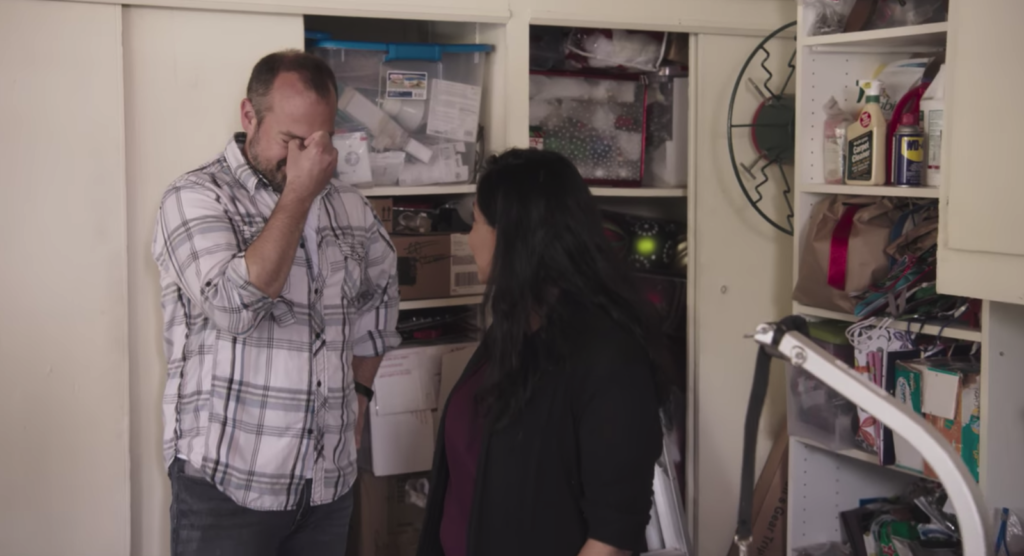
Things come to a crisis point when Sehnita and her husband Aaron try to KonMari the garage. The couple bickers about how much to get rid of, and the camera shows the husband leaving the garage in frustration over her reluctance to cull anything from their avalanche of baby clothing and toys. In a taped confessional, she ponders their argument: she has a strong personality, it could be a cultural difference. It could also be the nature of the feminized role of “household manager,” a position into which Sehnita—and Katrina—have both fallen. When women, and especially moms, are thrust into the position of both needing to have everything available to the household and to have everything pared down for the household’s mental health and optimal functioning, is it any wonder that the contradiction prevents them from accessing the clarity that “joy” is supposed to bring?
This paradox does not get resolved on Tidying Up. After the conflict in the garage, the next scene shows Sehnita holding her toddler in her lap, and in voiceover she states that she realized “Aaron and I don’t need a lot of things to be happy.” But how did Sehnita arrive at that conclusion? It’s not clear. The framing of the shot with Sehnita cradling her child suggests that family is what really matters, not the boxes of toys, games, and clothes in the garage. She has been conscripted into the joy economy as a way to resolve the conflict of the episode, but the viewer might reasonably doubt whether she has given over to its logic fully. Last we saw, she still longed to save her boxes and boxes of practical treasures.
Beyond the layers of motherhood, body image, and femininity that trouble the process of discerning joy, Sehnita must also reckon with her cultural identity as an immigrant. Born in Pakistan, she has several drawers filled with unworn Pakistani garments, and she explains that she wants to keep them for family events. In voiceover, Sehnita notes, “I feel such a disconnect to my culture to begin with. I don’t have a big Indian/Pakistani community being here in Los Angeles. So, you know, that’s a little piece of connection that I would like to hold onto.” When Kondo asks her to evaluate all the Pakistani garments in the drawers, she expresses a desire to keep them all. Her husband Aaron, who is white, replies with a wink, “Ah, but when’s the last time you wore them?” Although his tone is kind in this exchange, it is clear he does not understand Sehnita’s connection to these garments. Aaron is presented throughout the show as more willing to let go of clutter and is thus a better pupil in the project of Tidying Up; in this, the episode reproduces a stereotypical gendered logic of “wife who loves clothes to excess” and “husband who views this love as frivolous.” (Later I’ll discuss an episode where this gender dynamic is reversed.) In this case, however, that stereotypical logic masks a deeper connection that Sehnita feels to these particular scarves and kurtas, which bind her to a distant family and an even more distant homeland, offering a bulwark of identity and connectedness in her suburban life in LA.
Irina Dumitrescu writes about the attachments that immigrants have to their possessions and how it is difficult to let go of items when they are all that one has of the past, and all one might have in the future. She writes, “We are not supposed to hold onto things anymore, we educated, refined persons of higher sensibilities.” As Roland Barthes wrote about the over-sauced, overwrought cuisine of the 1960s working-class woman’s magazine (a cuisine of ideas, he called it), too much-ness is paradoxically the domain of the lower classes, while minimalism is the privilege of the elite. But as Dumitrescu observes, in the immigrant and refugee experience, “The sheer inconvenience of having to pack up fifty spice bottles or three hundred bellydance DVDs seems to be a promise of stability, an assurance that we will stay in one place. This time, we will not move again, we will find a perfect storage spot for our pet objects, arrange them in alphabetical order, and allow them to acquire a cozy layer of dust.” In clutter, there is security and preparedness. Yet the KonMari method works against this security by optimizing the flexibility of the home: all its contents are known and organized, ready to be packed and moved for the next gig. The show’s very diversity of participants reveals how her advice is better suited for those with more privilege, those who enjoy an unencumbered view of possessions because they have more housing or employment stability. The logic of the joy economy is thus raced and classed.
The KonMari method does not acknowledge these racial and class dimensions; instead it offers joy as a magical resolution to Sehnita’s problem of how to maintain her cultural identity through her belongings. Sentimental music plays as Kondo helps Sehnita organize her Pakistani scarves. She realized through this process that she didn’t use them often because they were stacked on top of one another, and by organizing them so that they are all visible and accessible, she can incorporate them into her daily wardrobe, suffusing it with joy. In this way, her heritage is made vital again through the implementation of tidying systems, despite physical disconnectedness from her Pakistani family.
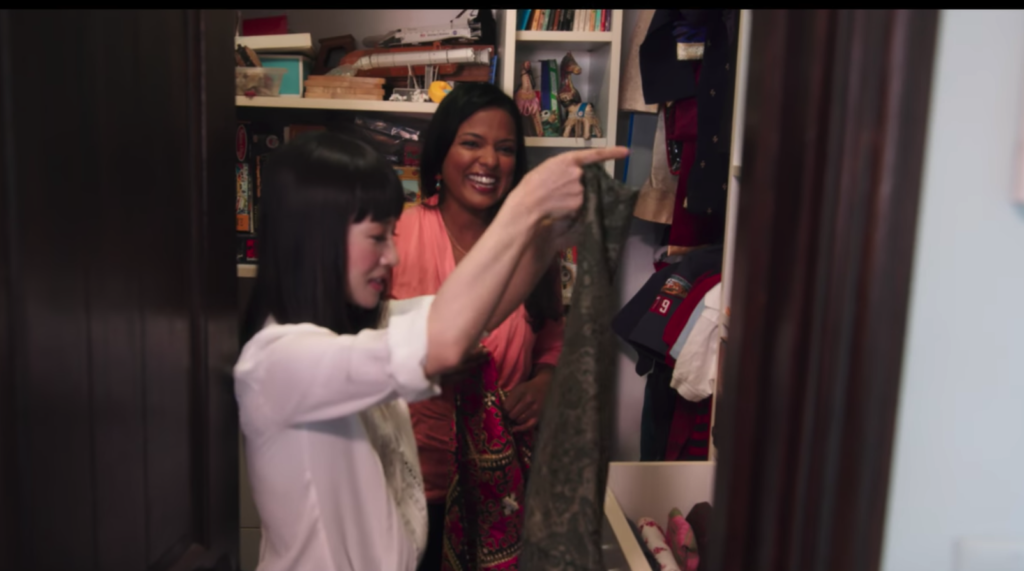
It is significant that the only other participant who self-identifies on Tidying Up as an immigrant also has trouble letting go of things and giving over to the joy economy. In “Making Room for Baby,” Mario, the child of Guatemalan immigrants, needs to free up a room for a nursery, but has trouble getting rid of sentimental items. They are mementos of the sacrifices his parents made; for instance, a coveted Starter jacket his father gave him one Christmas despite being unemployed. Mario’s problem, as it is framed on the show, is his love of athletic shoes, which is bound up in his love for American sports stars. He recounts that when he first started drawing a paycheck, he looked up to them as icons of a particularly spectacularized kind of American success that elevates young men of color to the status of sports superstar. Later in the episode, when he confronts his shoe collection using the KonMari method and learns to discern which of them “truly” spark joy, he acknowledges in voiceover that at one point he was $10,000 in debt on account of his shopping. The episode’s narrative arc concludes with Mario finally acknowledging that he wants to change his behavior and that he doesn’t want his new child to be so attached to material things as status symbols. He thus sheds his protective layer of immigrant attachments to become flexible, optimized, and ready to become a procreative adult.
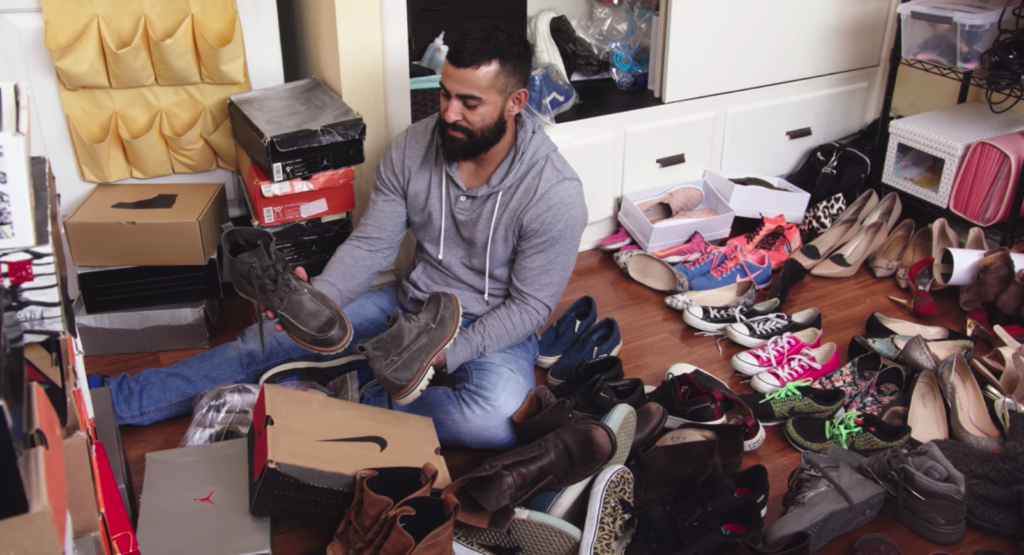
Like Sehnita, Mario is pathologized in the episode, in the sense that he needs to go through the transformative logic of the makeover to become his optimal self, appropriately attached to his things and ready to take on new adult responsibilities. Their partners are depicted as already appropriately attached to their items, and suffering at the mercy of their spouse’s outsized, imbalanced passions. At the end of the episode, Mario has gotten his shoe collection down from 150 to 45 pairs, and he pledges to be more intentional by wearing the shoes he’s kept. Mario and Sehnita “graduate” from their compulsive, feminized, and/or immigrant behavior when they learn how to be appropriately attached to their things. He has traded a system in which one is tied to goods as status symbols for one in which one is allowed to be tied to material things for idiosyncratic, affective reasons, namely joy. This system is reliant on the notion that you know what brings you happiness. It also presumes you can afford to cycle through goods at a middle-class American pace at all.
Conclusion: The Closed Loop’s Ecological and Social Costs
Once successfully optimized, the households on Tidying Up have learned to live with their belongings in a feedback loop of rationalized joy. Marie Kondo’s translator says to a young couple in the final episode, “The point of this process isn’t to eliminate things; it’s really to confirm how you feel about each and every item that you possess.” If the point is not to eliminate things, or to open up a conversation about waste and consumption, then what Tidying Up ends up doing is continuing to affirm the emotional bonds that underwrite our attachment to things—and thus ensures that we’ll continue to be attached to new things as they are put in front of us.
Affirming our bonds with things means that the cycle of accumulation is neither acknowledged nor critiqued on Tidying Up. At the end, despite the show not advocating any direct consumption, participants remain tethered to the world of consumable goods as a source of joy and transformative potential. The KonMari method assumes that joy is an affective charge that waxes and wanes as new objects cycle in, and then out, of our lives. It is expressly designed to accommodate new belongings, and to encourage us to discard old, less joyful ones. The method thus dovetails with the ideologies embedded in the consumer industries, which work hard to position new goods as rewards that spark joy, a state of things that Eva Illouz calls “emotional capitalism.” Put another way, “sparking joy” shares a logical structure with the disciplining function of the happiness enterprise as Binkley describes it: we are enjoined to the idea of selfhood that is built upon our belongings, an idea thatdrives capitalist accumulation in the first place. And accumulation and extraction are the twinned logics of neoliberal capitalism itself.
There is also the looming ecological crisis of waste, which donations do very little to mitigate. The accumulation cycle that Tidying Up espouses is not sustainable from either an ecological or a social standpoint; donating one’s no-longer-loved items is contingent on demand for the outpouring of donations. Salvation Army and other resale organizations only take what they can sell. Many have seen record donations this January that they link to the popularity of Tidying Up. Moreover, the accumulation and decluttering cycle of the middle and upper classes depends intrinsically on the continued existence of an underclass who need their secondhand goods.
Despite anxious repudiations of Kondo’s method as too austere and minimalist (including social media rumors accusing her of limiting people to 30 books), this fear is misplaced. In fact, one must tread an extremely fine line in the KonMari process: keeping exactly what you, in your singularity, love—no more or less. And I don’t wish to deny that there is some happiness, and a sense of control, to be gained from domestic optimization, in a world where many people desperately need, and deserve, such happiness and control. But we should not forget that beyond these benefits, which are enjoyed by people at the individual level, domestic optimization serves an altogether different master. Tidying Up’s promise to stave off insecurity makes it exemplary of the neoliberal happiness project, and the neoliberalization of domesticity itself. In other words, Tidying Up and other forms of domestic optimization grease the wheels of neoliberal disinvestment. It makes people better suited to work within it. But it is sink or swim: become proficient at discerning and regulating your emotional life, and thus your home life, or drown in the chaos of runaway marketization. Failure to do this could amount to a failure to get by at all.
Those who are not optimized appropriately to the grinding conditions of the marketplaces of employment, who accrue debt, who cannot save for retirement or capitalize themselves through real estate investments and education, are also sliding further backward into attrition and decline. It’s worth remembering that this population is not even a minority of Americans. It is most of us: women, the working class, people of color, immigrants, disabled people, and so on. For Lauren Berlant, life-building in these conditions is simultaneously a kind of “slow death.” The prevailing economic order is designed to produce these effects; they are the inevitable result of an order that subsumes all other logics under those of extraction and accumulation. We should see burnout, then, for what it is: the deliberate output of neoliberal market systems designed to extract value from people as nodes in a financial grid.
